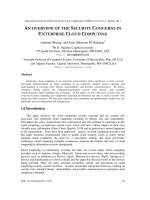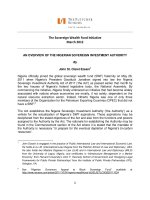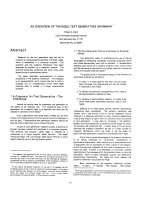The intelligible universe an overview of the last thirteen billion years 2nd ed
Bạn đang xem bản rút gọn của tài liệu. Xem và tải ngay bản đầy đủ của tài liệu tại đây (17.49 MB, 368 trang )
THE
INTELLIGIBLE
UNIVERSE
An Overview of
the Last Thirteen
Billion Years
2nd Edition
This page intentionally left blank
THE
INTELLIGIBLE
UNIVERSE
An Overview of
the Last Thirteen
Billion Years
2ND EDITION
JULIO A GONZALO
Universidad Autbnoma de Madrid
Spain
\bWorld Scientific
N E W JERSEY
*
LONDON
*
SINGAPORE
*
BElJlNG
*
SHANGHAI
*
HONG KONG
*
TAIPEI
*
CHENNAI
A-PDF Merger DEMO : Purchase from www.A-PDF.com to remove the watermark
Published by
World Scientific Publishing Co. Pte. Ltd.
5 Toh Tuck Link, Singapore 596224
USA office: 27 Warren Street, Suite 401-402, Hackensack, NJ 07601
UK office: 57 Shelton Street, Covent Garden, London WC2H 9HE
British Library Cataloguing-in-Publication Data
A catalogue record for this book is available from the British Library.
THE INTELLIGIBLE UNIVERSE (2nd Edition)
An Overview of the Last Thirteen Billion Years
Copyright © 2008 by World Scientific Publishing Co. Pte. Ltd.
All rights reserved. This book, or parts thereof, may not be reproduced in any form or by any means,
electronic or mechanical, including photocopying, recording or any information storage and retrieval
system now known or to be invented, without written permission from the Publisher.
For photocopying of material in this volume, please pay a copying fee through the Copyright
Clearance Center, Inc., 222 Rosewood Drive, Danvers, MA 01923, USA. In this case permission to
photocopy is not required from the publisher.
ISBN-13
ISBN-10
ISBN-13
ISBN-10
978-981-279-410-9
981-279-410-7
978-981-279-411-6 (pbk)
981-279-411-5 (pbk)
Printed in Singapore.
ChianYang - The Intelligible Universe.pmd
1
6/26/2008, 3:52 PM
To my brothers Bernardo, José, Manuel and Leopoldo, their wives and
children.
To our parents, Leónides and Concepción, who are already in the
presence of their Creator.
This page intentionally left blank
Contents
Prologue to 2nd Enlarged Edition ................................................................ xiii
Acknowledgements and Credits .....................................................................xv
The Intelligible Universe (Shanghai/Madrid 1993) ........................................1
1. Man and His Universe ...................................................................................3
1.1 Einstein’s Eternal Mystery ...................................................................3
1.2 From Antiquity to the XVI Century .....................................................4
1.3 From Galileo and Newton to Kirchhoff..............................................15
1.4 The XX Century .................................................................................21
Bibliography.......................................................................................................28
2. The Importance of Precision .......................................................................30
2.1 The Last Word in Physics...................................................................30
2.2 Precise Astronomical Observations ...................................................32
2.3 The New Generation of Telescopes....................................................42
Bibliography.......................................................................................................49
3. Masses, Distances and Times in the Universe ............................................50
3.1 Masses ................................................................................................50
3.2 Distances ............................................................................................57
3.3 Times ..................................................................................................64
Bibliography.......................................................................................................70
4. Relativistic Cosmology ...............................................................................72
4.1 Relativity, Special and General .........................................................72
4.2 The Cosmological Dynamic Equations .............................................74
vii
viii
The Intelligible Universe
4.3 The Matter Dominated and the Radiation Dominated Eras ...............83
4.4 The Cosmic Baryon to Photon Ratio .................................................87
Bibliography.......................................................................................................89
5. The Fundamental Physical Forces in the Universe......................................91
5.1 Gravitational, Electromagnetic and Nuclear Forces ..........................91
5.2 Conservation Laws .............................................................................98
5.3 Elementary Particles ........................................................................100
5.4 Universal Constants .........................................................................104
5.5 Understanding the Universe, and Open-Ended Process ..................108
Bibliography.....................................................................................................109
6. Cosmology and Transcendence .................................................................111
6.1 Towards the Confines of the Universe ............................................111
6.2 Observable Data and Big Bang Model .............................................115
6.2.1 Approximately isotropic distribution of galaxies in space.....115
6.2.2 Universal recession of the galaxies .......................................116
6.2.3 Relative abundance of 4He and other primordial light
elements .................................................................................117
6.2.4 Cosmic background radiation ................................................119
6.3 Implications of Contemporary Cosmology ......................................121
6.4 The Physical Universe and Its Creator .............................................124
6.5 God and the Scientists ......................................................................126
Bibliography.....................................................................................................128
The Cosmic Background Radiation (El Escorial 1993)...............................131
7. The COBE Project, by John C. Mather .....................................................133
8. COBE Observations of the Early Universe, by George F. Smoot ............169
8.1 Introduction ......................................................................................169
8.2 COBE Mission .................................................................................171
8.3 DMR Instrument ..............................................................................174
8.4 DMR Limits on Potential Systematica ............................................176
8.5 DMR Observations...........................................................................177
8.6 DMR Result Discussion ..................................................................183
8.7 DIRBE Measurements .....................................................................188
8.8 FIRAS Instruments Descriptions .....................................................191
Contents
ix
8.9 FIRAS Measurements ......................................................................193
8.10 FIRAS Interpretation .......................................................................197
8.11 Summary ..........................................................................................202
Bibliography.....................................................................................................202
The Last Thirteen Billion Years… (Krakow, 1998/Madrid, 2002) ............205
9. Unexpected Coincidence between Decoupling and Atom Formation
Times .........................................................................................................207
9.1 Introduction ......................................................................................208
9.2 Radiation/Matter Equality Temperature ..........................................209
9.3 Atom Formation ...............................................................................213
9.4 Concluding Remarks .......................................................................215
Bibliography.....................................................................................................216
10. An Amazing Story: From the Cave Man to the Apollo Mission ..............217
Bibliography.....................................................................................................227
11. From the Big Bang to the Present .............................................................228
Bibliography.....................................................................................................240
12. Astrophysical Cosmology Around Year 2000 AC ....................................241
12.1 The COBE Project............................................................................241
12.2 The Hubble Space Telescope ...........................................................245
12.3 The Spacial Mission Hipparcos .......................................................252
Bibliography.....................................................................................................259
The Microwave Anisotropy Probe (Singapore/Madrid, 2005) ..................261
13. The Report of the WMAP’s First Year Observation in the NY Times:
02/12/2003.................................................................................................263
Bibliography.....................................................................................................271
The Medieval Roots of Contemporary Science (Oviedo, 2007) ..................273
14. Why Not in China? ....................................................................................275
14.1 Why Not in China.............................................................................275
x
The Intelligible Universe
14.2 Early Medieval “Natural Philosophers” ..........................................278
Bibliography.....................................................................................................281
15. Tomas Aquinas and Roger Bacon .............................................................282
15.1 Tomas Aquinas and the Ways to God ..............................................282
15.2 Roger Bacon and the Experimental Method.....................................285
Bibliography.....................................................................................................286
16. From Buridan and Oresme to Copernicus and Newton ............................287
Bibliography.....................................................................................................293
17. The Wisdom of God Manisfested in the Works of Creation ....................294
17.1 Physicists ..........................................................................................295
17.2 Chemists ...........................................................................................299
17.3 Mathematicians ...............................................................................300
17.4 Geologists and Geographers ............................................................302
17.5 Astronomers ....................................................................................304
Bibliography.....................................................................................................306
Cosmic Numbers and Concluding Remarks ................................................307
18. Cosmic Numbers .......................................................................................309
Bibliography.....................................................................................................318
19. Concluding Remarks .................................................................................319
Bibliography.....................................................................................................320
Glossary...........................................................................................................321
Index ...............................................................................................................333
“The world must be some shape, and it must be that shape and no other;
and it is not self-evident that nobody can possibly hit on the right one.”
Gilbert Keith Chesterton,
“All is grist”, pp 7–8
(New York: Dodd, Mead, 1932)
xi
This page intentionally left blank
Prologue to 2nd Enlarged Edition
Except for the Second Section of this book (Chapters 7 to 10) in which
the “New Inflationary Cosmology” was considered in some detail by
distinguished invited speakers (John C. Matter and George F. Smoot) at
the Summer Course at El Escorial August 16 to 19, 1993, the rest of it
uses basically the standard Friedmann–Lemaitre Big Bang Cosmology
(with k < 0, Λ = 0) to describe most of the available observational evidence. The question of the reported cosmic acceleration (S. Perlmutter,
1998) which, according to Martin Rees (Spring, 2000), makes the case
for a non-zero cosmological constant strong but not overwhelming, is left
aside for the time being.
In the First Section (Chapters 1 to 6) the masses, distances and
times in the universe are discussed in the perspective of Relativistic
Cosmology, among other things. The material is the same as the one
included in the first edition of “The Intelligible Universe” (Shanghai
Educational Publishing House, 1993).
In the Second Section the English version of two invited lectures
given at El Escorial are reproduced. They were presented by John C.
Mather (COBE’s Project Scientist and FIRAS Principal Investigator) and
George F. Smoot (COBE’s DMR Principal investigator). The Spanish
version of these two lectures was publised in book form in “Cosmología
Astrofisíca” (Alianza Universidad: Madrid, 1994) eds. J. A. Gonzalo, J.
L. Sánchez Gómez, M. A. Alario. Other distinguished speakers at El
Escorial are given bellow:
Professors Ralph A. Alpher (New York), Antonio Fernandez Rañada
(Madrid), Jose L. Sánchez Gómez (Madrid), Manuel Catalan PerezUrquiola (Cadiz), Hans Elsässer (Heidelberg), Julio A. Gonzalo
xiii
xiv
The Intelligible Universe
(Madrid), Stanley L. Jaki (Princeton) author of “God and the
Cosmologists” and J. Lejeune (Paris).
As it is well known Jonh C. Mather and Goerge F. Smoot received the
2006 Nobel Prizes in Physics for “their discovery of the blackbody form
and anisotropy of the cosmic microwave background radiation”. To say
the least, these Nobel Prizes were not unexpected.
The Third Section (“The last thirteen billion years”) summarizes the
contents of a book published in Spanish by the UAM (Universidad
Autónoma de Madrid) one year after the results given in a paper by
N. Cereceda, G. Lifante and Julio A. Gonzalo in “Acta Cosmologica”
(Krakow, 1998) anticipating accurately the time elapsed since the Big
Bang as (13.7 ± 0.2) billion years.
The Fourth (very short) Section (from Chapter 6 of “Inflationary
Cosmology Revisited” World Scientific, 2005) comments on NASA’s
WMAP result reporting the first full year accurate observations resulting
in t0 = (13.7 ± 0.2) × 109 years and H0 = R0 /R0 = 67 km/Mpcsec.
The Fifth Section presets a historical discusion of the medieval roots
of contemporary science (physics and astronomy in particular) following
the steps of P. Duhem and S. L. Jaki. Not so long ago, for many physicist
chemists, mathematicians “the Wisdom of God is manifested in the
works of his Creation.”
And the (very short) last Section summarizes some important cosmic
numbers before making some relevant concluding remarks.
In summary, the universe is well made by a Wise, and Allpowerful
Creator, and man’s intellect, limited as it is, also is well made by Him in
His image and likeness. That is the reason why man can find the
intelligible Universe after all.
Julio A. Gonzalo
Madrid, 19 March 2007
Festivity of Saint Joseph
Acknowledgements and Credits
I wish to thank my good friends and colleagues Fr. Manuel M. Carreira,
SJ, Gines Lifante (UAM) and Manuel I. Marques (UAM) for reading the
manuscript and helpful comments; Mª Felisa Martínez Ruiz for revising
and typesetting the manuscript and helping to choose the illustrations;
Prof. Ralp A. Alpher for helpful correspondence during 1994–1996 and
Prof. Stanley L. Jaki for many instructive conversations during his
a-periodic visits to Madrid since 1990 to present.
Credits for the illustrations and photos appearring with minor or
major modifications in the various chapters of this book have been given
whenever possible and useful. In particular, the web pages of NASA
(www.nasa.gov) and ESA (www.esa.int/); Shanghai Educational
Publishing House (Shanghai, 1993); Harper and Row (New York, 1969);
Warner Books (New York, 1980); W. W. Norton & Co. (New YorkLondon, 1978); Alianza Universidad (Madrid, 1995); Ediciones UAM
(Madrid, 2002) and Mister Kerry Magruder for the pictures of Copernicus
Galileo, Kepler and Tycho.
xv
This page intentionally left blank
The Intelligible Universe
(Shanghai/Madrid 1993)
This page intentionally left blank
Chapter 1
Man and His Universe
1.1. Einstein’s Eternal Mystery
Albert Einstein (1879–1955) made once a famous remark to the effect
that the most surprising thing about the physical world is that it is
intelligible. Writing to his friend Maurice Solovine1 on March 30, 1952,
i.e. few years before his death, Einstein said “You find it surprising that I
think of the comprehensibility of the world (insofar as we are entitled to
speak of such world) as a miracle or an eternal mystery. But, surely,
a priori, one should expect the world to be chaotic, not to be grasped by
thought in any way. One might (indeed should) expect that the world
evidenced itself as lawful only so far as we grasp it in an orderly fashion.
This would be a sort of order like the alphabetical order of words. On the
other hand, the kind of order created, for example, by Newton’s
gravitational theory is of a very different character. Even if the axioms of
the theory are posited by man, the success of such a procedure supposes
in the objective world a high degree of order, which we are in no way
entitled to expect a priori.”
Man’s intelligence has been confronted through all the millennia of
recorded history with his personal reality as well as with the reality of the
physical universe. Sometimes, especially in antiquity but also in modern
times, man has viewed his personal reality as dissolved, so to say, in the
hugh reality of the physical universe. Sometimes, on the contrary, he has
seen the universe as a byproduct of his own mind. None of these two
viewpoints is entirely satisfactory. The physical universe can be
rationally defined as the totality of matter and energy (including of
3
4
The Intelligible Universe
course, electromagnetic radiation) in coherent interaction with one
another. Intelligibility, in its deepest sense, involves a higher quality in
man, the observer, a quality which is spiritual in nature. All cultures, all
developed languages, seem to contain, however veiled, this distinction
between the physical realm, dominated by brute inexorable forces, and
the spiritual realm. Man’s intelligence can discern -“read-into”- the
physical world, and in the spiritual world of his fellowmen as well, truth
beauty, unity, etc. A distinctive characteristic of man’s intellectual
operations is that they can go wrong, they can make mistakes, in clear
contrast with the generally deterministic behavior of the material world.
1.2. From Antiquity to the XVI Century
A cursory overview of the historical record brings forth the well known
fact of man’s curiosity and interest on cosmic regularities from the
earliest antiquity. Astronomy is said to be the oldest of pure sciences.
Soon afterwards men’s interests in the heavens were connected with
practical matters, the first of which was to provide a basis for the
calendar. The Chinese, Egyptians and Mayas had all very old working
calendars, based on astronomic observations,2 which helped them to
carry out in due time their agricultural labors, to record past events and to
calculate in advance dates for future plans.
The time needed for Earth to complete an orbit around the sun is 365
days, 5 hr, 48 min and 46 sec. On the other hand the moon passes
through its phases in 29 days and 12 hr, approximately, and twelve lunar
months amount to slightly more than 354 days, 8 hr and 48 min.
Therefore defining an exactly overlapping solar and lunar year meets
with inescapable difficulties. On one hand, months and years cannot be
divided exactly into days. On the other, years cannot be easily divided
into months. To reconcile and harmonize solar and lunar records has
been a major problem for men of ancient civilizations, and different
peoples have used different intercalation procedures.
In the year 45 B.C., Julius Caesar, who as “pontifex maximus” had
the power of regulating the calendar, added 90 days to the year 46 B.C.
Man and His Universe
5
(making up for accumulated delays) and changed the years’ length to 365
and 1/4 days, introducing therefore the bissextile year, on the advice of
the astronomer Sosigenes. This was pretty close, but sixteen centuries
latter the accumulated surplus time had displaced the vernal equinox
from March 21 (the date set in the 4th century) to March 11. In 1582
Pope Gregory XIII rectified this error excepting from the condition of
bissextile those years ending in hundreds, unless they are divisible by
400. Then the actual solar year equal to 365.2421 days, was
approximated by
365 + 1/4 − 1/100 − 1/400 = 365.2425 days
(1.1)
which is close enough, so that correction of one day is required only
after approximately 2500 years, a conveniently long time span.
The early astronomers of Babylonia, Assyria and Egypt were priests
and a strong motivation for detailed study of the apparently irregular
planetary motions (planet = “wanderer”) was the preparation of
horoscopes. An all pervasive trend3 in those ancient cultures, as well as
in the most brilliant of them all, the Greek culture, was that going down
from the higher realm of the fixed stars, incorruptible and moving in
perfectly orderly fashion, to the realm of the planets, less orderly and
incorruptible, and finally to the sublunary world, the degree of disorder
increased steadily, being the lower governed to a greater or lesser extent
by the higher realms. This explains the need for horoscopes to predict the
future and the mixed character (astronomical - astrological) of their
investigations of the heavens.
Table 1.1 gives succinctly some of the major achievements
concerning astronomy up to the times just before Galileo and Newton.
The pattern of the constellations or star groupings was inherited by
Greeks and Egyptians from the oldest Mesopotamian culture, which,
more than 5000 years ago, divided the band of stellar background near the
plain defined by the apparent diurnal rotation of the sun around the Earth
in twelve equally spaced arc segments.
6
The Intelligible Universe
Fig. 1.1. Apparent trajectory of the sun through the sky.
While some archeologists believe the original number4 of zodiacal
constellations was six, this may have been changed at later times,
resulting in the twelve familiar constellations depicted in Fig. 1.1. In the
resulting division of the zodiac by Mesopotamian astronomersastrologers there is a definite tendency to duplicate things: two serpents,
two slayers of serpents, two fishes, two streams and the twins making up
Gemini. By the year 3000 B.C. the easily recognizable constellations
Taurus and Scorpio were at the two opposite equinoctial points (day and
night of equal duration) corresponding to the days marking the beginning
of spring (vernal equinox) and the beginning of fall (autumnal equinox).
An observer watching at sunrise in the vernal equinox could see the
position of the sun in the zodiac at Taurus by the year 3000 B.C. Two
thousand years later, however, Taurus had moved one step and what the
observer could see at sunrise in the vernal equinox was the constellation
of Aries. And so forth. Towards the end of the second century B.C. the
great Greek astronomer Hipparcos, relying on ancient Babylonian
records was able to describe this apparent periodic motion of the celestial
spheres, which, we now know, is due to the precession of the Earth axis
around a line perpendicular to the zodiacal plane.
Man and His Universe
7
Table 1.1. Landmark achievements concerning astronomy (BC–1600).
YEAR
1500
AUTHOR
Kepler (1571–1630)
Tycho Brahe (1546–1601)
Copernicus (1473–1543)
Buridan (c.1358)
Alfonsine Tables (c.1252)
1000
ACHIEVEMENT
Laws of planetary motion
Accurate and systematic
observations
“De revolutionibus orbium
celestium”
Impetus theory for celestial
bodies
Improved planetary data,
compiled by moorish, jewish
and christian scholars under
Alphonse X of Castile.
Various arab scholars
Adoption of hindu numeral and
decimal system, trigonometry.
Tabit ibn-Korra (836–931)
Translator of Euclid,
Apollonius, Archimedes and
Ptolemy
Ptolemy (85–165)
“Almagest”
Planetary data described by
epicycles
Use of angular parallax
Hipparcos (190–120)
Accurate catalog of stars
Precession of equinoxes
Distance to Earth and moon
First heliocentric proposal
Diameter of Earth
Oldest Chinese catalog of stars
Systematization of knowledge
500
0
Aristarchus (c.150)
Erathostenes (284–192)
Chih Chen (about 350)
Aristotle (384–322)
-500
Pythagoras (c.572–c.497)
Thales (c.640–c.552)
Spherical Earth
Angular diameter of sun as a
fraction of zodiacal circle
8
The Intelligible Universe
A full round of precession amounts to about 26000 years, i.e.
(2160 years/constellation) × (12 constellations) ≈ 26000 years (1.2)
Some Greek philosophers fancied this very long period as the Great
Year, that is, the time span after which an “eternal return” is completed
and things in the universe start all over again. Of course, fairly accurate
and sustained observations were required to identify and characterize this
slow periodic motion in the heavens.
Very early observers could predict eclipses with fair accuracy, using
their tables of lunar motion, although they did not understand their cause.
Pythagoras (c.572–c.497) produced an ideal model of the universe in
which this was conceived as a series of concentric imaginary spheres in
which the sun, the moon and the five then known planets, as well as the
Earth (and an imaginary counter-Earth) rotated around an invisible
“central fire” (see Fig. 1.2), producing the “music of the spheres”.
Fig. 1.2. Pythagorean model of the universe.
Erathostenes (284–192), using a very simple method, to be discussed
in more detail later on, measured the central angle corresponding to a
relatively long arc running South to North along the Nile river. In this
way he was able to calculate within an error of only 5% the perimeter of
the Earth, therefore proving its sphericity. Old reports of Egyptian sailors
who had circumnavigated Africa clockwise had indicated that, in going
upwards from what is now known as the cape of Good Hope, they had









